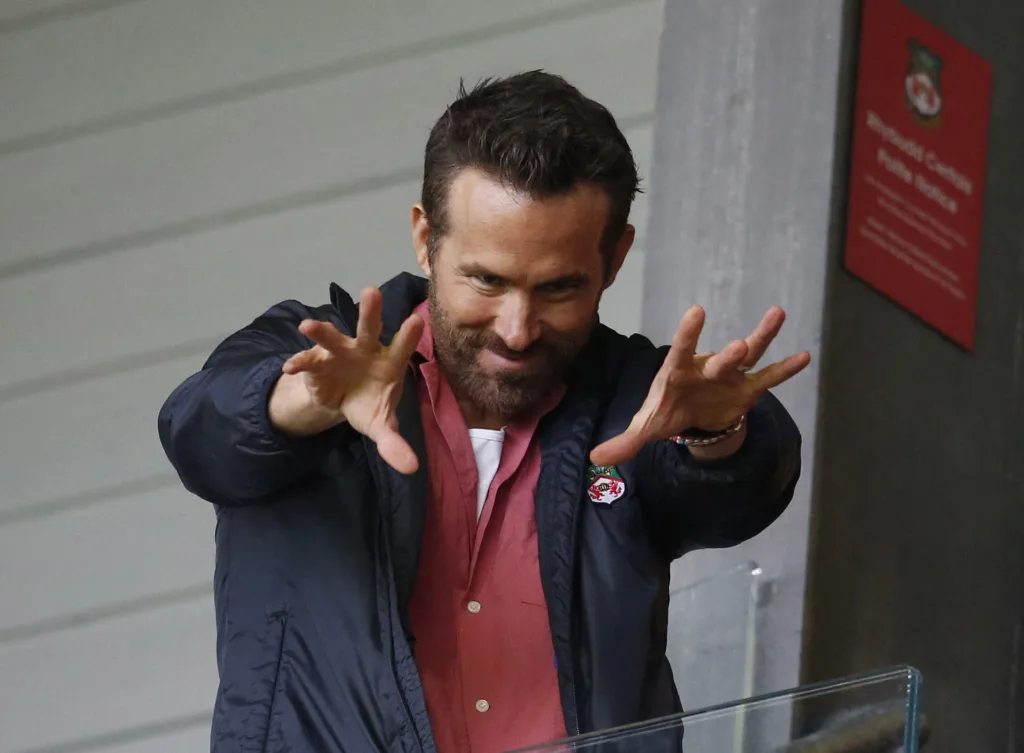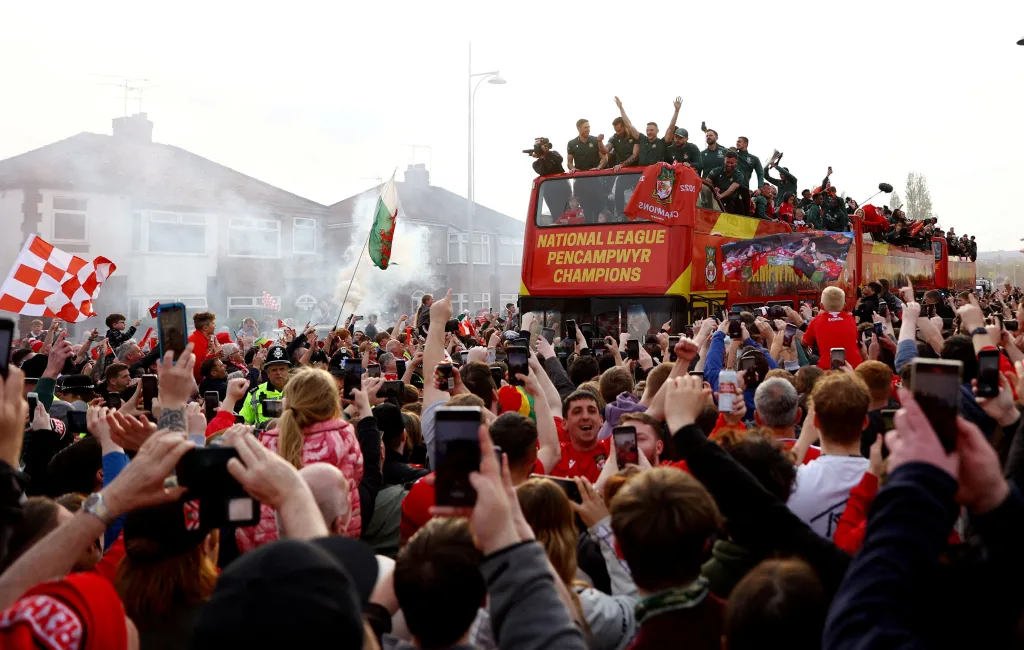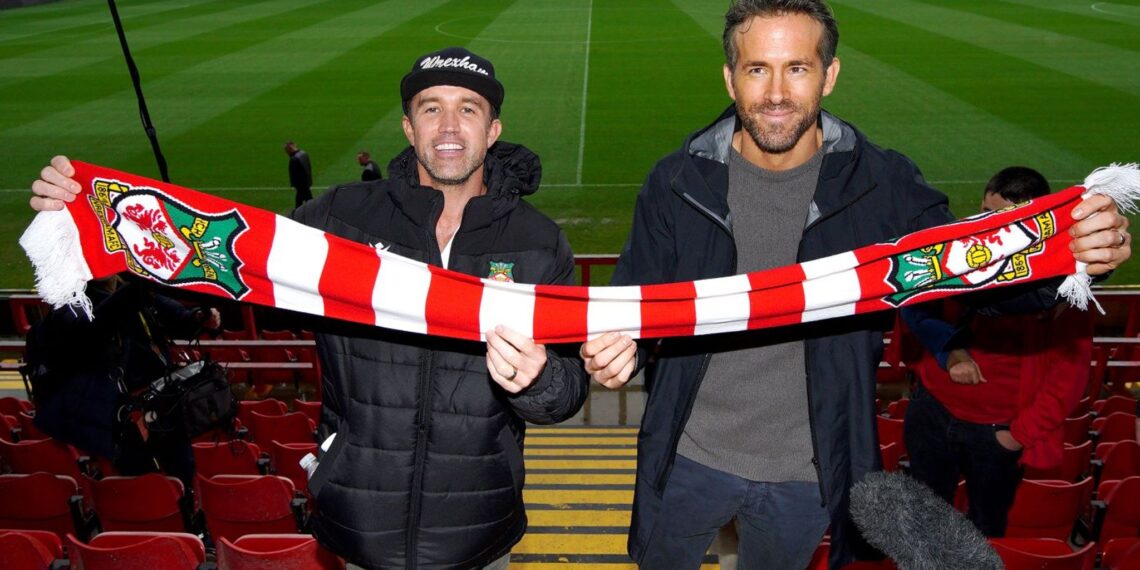The Hollywood duo of Ryan Reynolds and Rob McElhenney are creating waves far beyond the entertainment industry, with their ambitious vision for Wrexham AFC now playing a pivotal role in the UK’s bid to host the 2035 FIFA Women’s World Cup. The pair’s transformative investment in the Welsh club has caught the attention of FIFA officials and positioned the historic Racecourse Ground as a potential venue for football’s most prestigious women’s tournament.
Table of Contents
The Hollywood Legacy Taking Shape
Football Association of Wales chief executive Noel Mooney described the potential Women’s World Cup involvement as creating a “legacy” for Reynolds and McElhenney, emphasizing how their investment extends far beyond typical ownership. “The city and the club have a chance to bring a World Cup to North Wales. What a legacy for Ryan and Rob to leave Wrexham,” Mooney stated, highlighting the transformative impact of their involvement.

The strategic timing couldn’t be better. The UK has emerged as the sole bidder for the 2035 Women’s World Cup after FIFA confirmed they submitted the only “valid bid” for the tournament, giving Reynolds and McElhenney’s Wrexham project a genuine pathway to hosting World Cup matches.
Stadium Transformation: From 13,000 to 55,000 Capacity
The ambitious redevelopment plans showcase the scale of Reynolds and McElhenney’s vision. Currently, the Racecourse Ground holds 13,341 spectators, but the Hollywood owners have revealed plans to eventually expand capacity to between 45,000 and 55,000 seats, which would place it among the largest stadiums in the UK.
Immediate Development Phase
The immediate focus centers on the new Kop Stand, designed by renowned architects Populous, who previously created the Tottenham Hotspur Stadium. The new 5,500-capacity Kop Stand will feature safe standing areas, hospitality options, and accessible seating, with construction targeting completion by summer 2026.
However, recent developments suggest even more ambitious plans. Wrexham submitted revised plans in August 2025 to add an extra 2,250 seats to the second tier of the new Kop, bringing total capacity to 7,750 and the stadium’s overall capacity to around 18,000.
Long-term Vision
McElhenney revealed in interviews that they have “a plan in place right now that would work from stand to stand so eventually you get all four sides,” potentially accommodating “between 45,000 and 55,000 people”. This would transform Wrexham into one of the most significant football venues in Wales.
Strategic Importance for 2035 Women’s World Cup
The Football Association of Wales has identified two key venues for their World Cup strategy: Cardiff City Stadium in the south and Wrexham’s redeveloped Racecourse Ground in the north. The FAW wants Wrexham’s redeveloped STōK Cae Ras home as their northern venue among the 16 stadiums planned for the expanded 48-team tournament.

Global Recognition Factor
FAW chief executive Mooney emphasized how “People all over the world are talking about Wrexham and that inspires partners like FIFA, commercial bodies and Governments to get involved”. The global attention from the “Welcome to Wrexham” documentary series has elevated the club’s profile exponentially.
Historical Significance
The Racecourse Ground holds the distinction of being the world’s oldest international football venue still in use, having hosted Wales’ first ever international home game against Scotland on March 5, 1877. This historical pedigree adds gravitas to the World Cup bid.
Financial Investment and Timeline
The scale of investment demonstrates Reynolds and McElhenney’s commitment to the project:
Stadium Development Costs and Timeline
| Phase | Capacity Addition | Timeline | Investment |
|---|---|---|---|
| New Kop Stand | +7,750 seats | Summer 2026 | £17M+ (Welsh Gov support) |
| Phase 2 (Wrexham Lager Stand) | +4,200 seats | 2027-2028 | TBD |
| Full Stadium Expansion | Up to 55,000 total | Long-term | Estimated £100M+ |
2035 World Cup Timeline
| Milestone | Date | Status |
|---|---|---|
| UK Bid Submission | Q4 2025 | In Progress |
| FIFA Decision | April 30, 2026 | Pending |
| Tournament | Summer 2035 | 10 years away |
Impact on Welsh Football Development
The Reynolds-McElhenney effect extends beyond infrastructure. Mooney noted that “Wrexham has already started collecting a lot of our national team players, and will produce lots of players for us in the future with their investment in youth development and Academy”.
Symbiotic Relationship
“There is a symbiotic relationship there where we can create a lot of value for each other,” Mooney explained, highlighting how the club’s success benefits Welsh football nationally while the national team’s association enhances Wrexham’s profile.
Competitive Context and Challenges
While Wrexham positions itself for World Cup glory, they face significant competition. Manchester United have set their sights on hosting the final of the 2035 Women’s World Cup at a proposed new 100,000-seat stadium, with the project estimated to cost £2bn.
However, Wrexham’s unique selling points include:
- Historical significance as the world’s oldest international football stadium
- Global brand recognition through Hollywood ownership
- Strategic location in North Wales
- Community-centered approach to development
Looking Ahead: The 2026 Milestone
The immediate test comes with Wales hosting the 2026 European Under-19 Championship, with all matches played in the north and the Cae Ras staging the final. This tournament will serve as a crucial proving ground for Wrexham’s World Cup ambitions.
“Next year marks the 150th anniversary of the FAW, which was founded in Wrexham,” adding extra significance to the milestone year and the push for international recognition.
Ryan Reynolds and Rob McElhenney’s involvement with Wrexham represents more than celebrity ownership—it’s a transformative vision that could reshape Welsh football forever. Their ambitious stadium expansion plans, combined with the UK’s pole position for the 2035 Women’s World Cup, create an unprecedented opportunity to establish Wrexham as a global football destination.

As one FAW official summarized: “What Ryan and Rob are doing is amazing,” capturing the sentiment that this Hollywood-Welsh partnership could indeed create a lasting legacy that extends far beyond the entertainment headlines.
The next decade will reveal whether this ambitious vision becomes reality, but the foundations are already being laid for what could be one of the most remarkable transformations in modern football history.
Read More: Official: Newcastle United Secure £43m Jacob Ramsey Transfer from Aston Villa
FAQs
When will Ryan Reynolds and Rob McElhenney’s new Wrexham stadium be ready?
The new Kop Stand is targeted for completion by summer 2026, coinciding with Wales hosting the UEFA European Under-19 Championship. The full stadium expansion to 45,000-55,000 capacity will be a long-term project spanning multiple phases over several years.
Is the UK guaranteed to host the 2035 Women’s World Cup?
While the UK is the sole bidder, FIFA will make the official decision on April 30, 2026. The UK’s position as the only valid bidder makes their selection highly likely, but formal approval is still required.
How much are Ryan Reynolds and Rob McElhenney investing in Wrexham’s stadium?
The Welsh Government has provided over £17 million for the new Kop Stand. The total investment for the complete stadium transformation could exceed £100 million, though specific figures haven’t been disclosed by the owners.
What makes Wrexham’s Racecourse Ground special for the World Cup bid?
The stadium is the world’s oldest international football venue still in use, dating back to 1877. Combined with the global attention from “Welcome to Wrexham” and the owners’ Hollywood profile, it offers unique historical significance and modern appeal.
How does Rob McElhenney’s role compare to Ryan Reynolds in this project?
Both actors are equal co-owners and share the same vision for Wrexham’s transformation. McElhenney has been particularly vocal about the stadium expansion plans, while both are actively involved in strategic decisions and community engagement.








